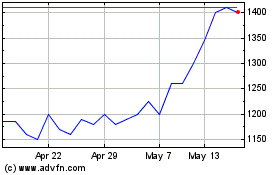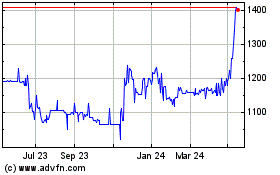reclassified to profit or loss at a later date. However,
dividends on such investments are recognised in profit or loss,
rather than other comprehensive income unless they clearly
represent a partial recovery of the cost of the investment.
Investments in equity instruments in respect of which an entity
does not elect to present fair value changes in other comprehensive
income would be measured at fair value with changes in fair value
recognised in profit or loss.
The standard requires that derivatives embedded in contracts
with a host that is a financial asset within the scope of the
standard are not separated; instead the hybrid financial instrument
is assessed in its entirety as to whether it should be measured at
amortised cost or fair value.
IFRS 10 - Consolidated Financial Statements, IFRS 12 -
Disclosure of Interests in Other Entities, IFRS 13 - Fair Value
Measurements were issued by the IASB in May 2011.
All of these standards are effective for annual periods
beginning on or after 1 January 2013. The Group is currently in the
process of assessing the impact, if any, of these standards on the
Group's financial statements.
Adoptions of new standards
The following new standards and amendments are mandatory for the
financial year beginning 1 January 2010.
IAS 27, 'Consolidated and Separate Financial Statements' - A
revised version of IAS 27 was issued in May 2010. The revised
standard requires the effects of all transactions with
non-controlling interests to be recorded in equity if there is no
change in control and these transactions will no longer result in
goodwill or gains and losses. The standard also specifies the
accounting when control is lost. Any remaining interest in the
entity is re-measured to fair value, and a gain or loss is
recognised in profit or loss. IAS 27 (revised) has had no impact on
the current period, as none of the non-controlling interests have a
deficit balance; there have been no transactions whereby an
interest in an entity is retained after the loss of control of that
entity.
'Improvements to IFRS' (issued in May 2010) - The Improvements
project contains numerous amendments to IFRS that the IASB
considers non-urgent but necessary. 'Improvements to IFRS' comprise
amendments that result in accounting changes for presentation,
recognition or measurement purposes, as well as terminology or
editorial amendments related to a variety of individual IFRS
standards. Most of the amendments are effective for annual periods
beginning on or after 1 January 2010. No material changes to
accounting policies arose as a result of these amendments.
Amendments to IAS 39 Financial Instruments: Recognition and
Measurement - Eligible Hedged Items - The amendments did not have a
significant impact on the Group's financial statements.
a) Income Recognition
Dividend income is recognised when the right to receive income
is established. Usually this is the ex-dividend date for equity
securities. Deposit interest is accrued on a day-to-day basis. Loan
interest is accounted for using the effective interest method. All
income is shown gross of any applicable withholding tax.
b) Investments
Classification
All investments of the Company, together with its subsidiaries
('the Group'), are designated into the financial assets at fair
value through profit or loss category. The investments are
purchased mainly for their capital growth and the portfolio is
managed, and performance evaluated, on a fair value basis in
accordance with the Group's documented investment strategy.
Therefore the Directors consider that this is the most appropriate
classification.
This category comprises financial instruments designated at fair
value though profit or loss upon initial recognition - these
include financial assets that are not held for trading purposes and
which may be sold. These are principally investments in listed and
unlisted equities.
Fair value measurement principles
Financial instruments are measured initially at fair value being
the transaction price. Subsequent to initial recognition on trade
date, all instruments classified as fair value through profit or
loss are measured at fair value with changes in their fair value
recognised in the Statement of Comprehensive Income. Transaction
costs are separately disclosed in the Statement of Comprehensive
Income.
Listed investments have been valued at the bid market price
ruling at the Statement of Financial Position date. In the absence
of the bid market price, the closing price has been taken, or, in
either case, if the market is closed on the Consolidated Statement
of Financial Position date, the bid market or closing price on the
preceding business day.
Fair Value of unlisted investments are derived in accordance
with the International Private Equity and Venture Capital
Association (IPEVCA) guidelines. Their valuation includes all
factors that market participants would consider in setting a price.
The primary valuation techniques employed to value the unlisted
investments are earnings multiples, recent transactions and the net
asset basis. Cost is considered appropriate for early stage
investments. The relevance of this methodology can be eroded over
time and in these cases the carrying values will be adjusted to
reflect fair value.
For certain of the Group's financial instruments, including cash
and cash equivalents, interest and dividends and interest
receivable and amounts due to and from broker, the carrying amounts
approximate fair value due to their immediate or short-term
maturity.
Derecognition of financial assets occur when the rights to
receive cash flows from financial instruments expire or are
transferred and substantially all of the risks and rewards of
ownership have been transferred.
Fair value measurement should be determined based on assumptions
that market participants would use in pricing an asset or
liability. As a basis for considering market participant
assumptions, IFRS 7 establishes a fair value hierarchy that gives
the highest priority to unadjusted quoted prices in active markets
(Level 1) and lowest priority to unobservable inputs (Level 3). The
three levels of the value hierarchy are as follows.
Level 1: Inputs that reflect unadjusted quoted prices in active
markets for identical assets or liabilities that the Company has
the ability to access at the measurement date;
Level 2: Inputs reflect quoted prices of similar assets and
liabilities in active markets and quoted prices of identical assets
and liabilities in markets that are considered to be inactive, as
well as inputs other than quoted prices that are observable for the
asset or liability either directly or indirectly; and
Level 3: Inputs that are unobservable for the asset or liability
and reflect the Investment Manager's own assumptions in accordance
with the accounting policies disclosed within note 2 to the
financial statements.
c) Other receivables
Other receivables do not carry any interest and are short term
in nature and are accordingly stated at their amortised cost as
reduced by appropriate allowances for impairment.
d) Cash and cash equivalents
Cash and cash equivalents consist of cash in hand and short term
deposits in banks with original maturities of less than three
months.
e) Other Payables and Accrued Expenses
Other payables and accrued expenses are not interest bearing and
are stated at their amortised cost.
f) Foreign Currency Translation
Items included in the Group's financial statements are measured
using the currency of the primary economic environment in which it
operates (the "functional currency"). This is the pound sterling
which reflects the Group's primary activity of investing in
sterling securities. The Group's shares are also issued in
sterling.
Foreign currency assets and liabilities have been translated at
the exchange rates ruling at the Consolidated Statement of
Financial Position date. Transactions in foreign currency during
the period have been translated into pounds sterling at the spot
exchange rate in effect at the date of the transaction. Realised
and unrealised gains and losses on currency translation are
recognised in the Consolidated Statement of Comprehensive
Income.
g) Realised and Unrealised Gains and Losses
Realised gains and losses arising on the disposal of investments
are calculated by reference to the cost attributable to those
investments and the sales proceeds, and are included in the
Consolidated Statement of Comprehensive Income. Unrealised gains
and losses arising on investments held at the Consolidated
Statement of Financial Position date are also included in the
Consolidated Statement of Comprehensive Income.
h) Financial Liabilities
All bank loans and borrowings are initially recognised at cost,
being the fair value of the consideration received, less issue
costs where applicable. After initial recognition, all interest
bearing loans and borrowings are subsequently measured at amortised
cost. Any difference between cost and redemption value has been
recognised in the Consolidated Statement of Comprehensive Income
over the period of the borrowings on an effective interest
basis.
Financial liabilities are derecognised from the Consolidated
Statement of Financial Position only when the obligations are
extinguished either through discharge, cancellation or
expiration.
i) Equity
Share Capital represents the nominal value of equity shares.
Share Premium represents the excess over nominal value of the
fair value of consideration received for equity shares, net of
expenses of the share issue. Share premium is debited for the
excess of redemption price over par value of shares.
Other Reserves and the Capital Redemption Reserve include all
current and prior results as disclosed in the Consolidated
Statement of Comprehensive Income. Other Reserves also includes the
deduction for the excess of consideration paid over nominal value
on share buy-backs.
j) Expenses
Expenses are recognised in the consolidated Statement of
Comprehensive Income upon utilisation of the service or at the date
they are incurred.
Oryx International Growth (LSE:OIG)
Historical Stock Chart
From Jun 2024 to Jul 2024

Oryx International Growth (LSE:OIG)
Historical Stock Chart
From Jul 2023 to Jul 2024
